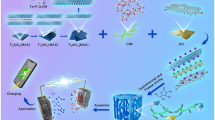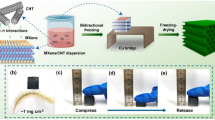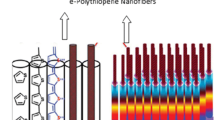Abstract
The large internal surface areas and outstanding electrical and mechanical properties of graphene have prompted to blend graphene with NiCo2O4 to fabricate nanostructured NiCo2O4/graphene composites for supercapacitor applications. The use of graphene as blending with NiCo2O4 enhances the specific capacitance and rate capability and improves the cyclic performance when compared to the pristine NiCo2O4 material. Here, we synthesized two different nanostructured morphologies of NiCo2O4 on graphene sheets by solvothermal method. It has been suggested that the morphologies of oxides are greatly influenced by dielectric constant, thermal conductivity, and viscosity of solvents employed during the synthesis. In order to test this concept, we have synthesized nanostructured NiCo2O4 on graphene sheets by facile solvothermal method using N-methyl pyrrolidone and N,N-dimethylformamide solvents with water. We find that mixture of N-methyl pyrrolidone and water solvent favored the formation of nanonet-like NiCo2O4/graphene (NiCoO-net) whereas mixture of N,N-dimethylformamide and water solvent produced microsphere-like NiCo2O4/graphene (NiCoO-sphere). Electrochemical pseudocapacitance behavior of the two NiCo2O4/graphene electrode materials was studied by cyclic voltammetry, chronopotentiometry, and electrochemical impedance spectroscopy techniques. The supercapacitance measurements on NiCoO-net and NiCoO-sphere electrodes showed specific capacitance values of 1060 and 855 F g−1, respectively, at the current density of 1.5 A g−1. The capacitance retention of NiCoO-net electrode is 93 % while that of NiCoO-sphere electrode is 77 % after long-term 5000 charge-discharge cycles at high current density of 10 A g−1.






Similar content being viewed by others
References
Simon P, Gogotsi Y (2008) Materials for electrochemical capacitors. Nat Mater 7:845–854
Chen S, Xing W, Duan J, Hu X, Qiao SZ (2013) Nanostructured morphology control for efficient supercapacitor electrodes. J Mater Chem A 1:2941–2954
Béguin F, Frackowiak E (2013) Supercapacitors: materials, systems, and applications. Weinheim, Wiley-VCH
Gogotsi Y, Simon P (2011) True performance metrics in electrochemical energy storage. Science 334:917–918
Xia X, Chao D, Fan Z, Guan C, Cao X, Zhang H (2014) A new type of porous graphite foams and their integrated composites with oxide/polymer core/shell nanowires for supercapacitors: structural design, fabrication, and full supercapacitor demonstrations. Nano Lett 14:1651–1658
Zhang LL, Zhao XS (2009) Carbon-based materials as supercapacitor electrodes. Chem Soc Rev 38:2520–2531
Pan H, Li J, Feng YP (2010) Carbon nanotubes for supercapacitor. Nanoscale Res Lett 5:654–668
Li X, Wei B (2013) Supercapacitors based on nanostructured carbon. Nano Energy 2:159–173
Lu Q, Chen JG, Xiao JQ (2013) Nanostructured electrodes for high-performance pseudocapacitors. Angew Chem Int Ed 52:1882–1889
Snook GA, Kao P, Best AS (2011) Conducting-polymer-based supercapacitor devices and electrodes. J Power Sources 196:1–12
Shi F, Li L, Wang XL, Gu CD, Tu JP (2014) Metal oxide/hydroxide-based materials for supercapacitors. RSC Adv 4:41910–41921
Rui XH, Tan H, Yan Q (2014) Nanostructured metal sulfides for energy storage. Nanoscale 6:9889–9924
Djire A, Ajenifujah OT, Sleightholme AES, Rasmussen P, Thompson LT (2015) Effects of surface oxygen on charge storage in high surface area early transition-metal carbides and nitrides. J Power Sources 275:159–166
Devadas A, Baranton S, Napporn TW, Coutanceau C (2011) Tailoring of RuO2 nanoparticles by microwave assisted “Instant method” for energy storage applications. J Power Sources 196:4044–4053
Li YF, Li SS, Zhou DL, Wang AJ, Zhang PP, Li CG, Feng JJ (2014) Facile controlled synthesis of MnO2 nanowires for supercapacitors. J Solid State Electrochem 18:2521–2527
Justin P, Meher SK, Ranga Rao G (2010) Tuning of capacitance behavior of NiO using anionic, cationic, and nonionic surfactants by hydrothermal synthesis. J Phys Chem C 114:5203–5210
Hou L, Yuan C, Yang L, Shen L, Zhang F, Zhang X (2011) Urchin-like Co3O4 microspherical hierarchical superstructures constructed by one-dimension nanowires toward electrochemical capacitors. RSC Adv 1:1521–1526
Meher SK, Ranga Rao G (2011) Effect of microwave on the nanowire morphology, optical, magnetic, and pseudocapacitance behavior of Co3O4. J Phys Chem C 115:25543–25556
Shivakumara S, Penki TR, Munichandraiah N (2014) Preparation and electrochemical performance of porous hematite (α-Fe2O3) nanostructures as supercapacitor electrode material. J Solid State Electrochem 18:1057–1066
Umeshbabu E, Rajeshkhanna G, Ranga Rao G (2014) Urchin and sheaf-like NiCo2O4 nanostructures: synthesis and electrochemical energy storage application. Int J Hydrog Energy 39:15627–15638
Jokar E, Irajizad A, , Shahrokhian S (2015) Synthesis and characterization of NiCo2O4 nanorods for preparation of supercapacitor electrodes. J Solid State Electrochem 19:269–274
Padmanathan N, Selladurai S (2013) Solvothermal synthesis of mesoporous NiCo2O4 spinel oxide nanostructure for high-performance electrochemical capacitor electrode. Ionics 19:1535–1544
Ding R, Qi L, Wang H (2012) A facile and cost-effective synthesis of mesoporous NiCo2O4 nanoparticles and their capacitive behavior in electrochemical capacitors. J Solid State Electrochem 16:3621–3633
Kong LB, Lu C, Liu MC, Luo YC, Kang L (2013) Effect of surfactant on the morphology and capacitive performance of porous NiCo2O4. J Solid State Electrochem 17:1463–1471
Zhang M, Guo S, Zheng L, Zhang G, Hao Z, Kang L, Liu ZH (2013) Preparation of NiMn2O4 with large specific surface area from an epoxide-driven sol–gel process and its capacitance. Electrochim Acta 87:546–553
Davis M, Gümeci C, Black B, Korzeniewski L, Hope-Weeks C (2012) Tailoring cobalt doped zinc oxide nanocrystals with high capacitance activity: factors affecting structure and surface morphology. RSC Adv 2:2061–2066
Xu Y, Wang XF, An C, Wang Y, Jiao L, Yuan H (2014) Facile synthesis route of porous MnCo2O4 and CoMn2O4 nanowires and their excellent electrochemical properties in supercapacitors. J Mater Chem A 2:16480–16488
Zhu M, Meng D, Wang C, Diao G (2013) Facile fabrication of hierarchically porous CuFe2O4 nanospheres with enhanced capacitance property. ACS Appl Mater Interfaces 5:6030–6037
Yuan CH, Wu HB, Xie Y, Lou XW (2014) Mixed transition-metal oxides: design, synthesis, and energy-related applications. Angew Chem Int Ed 53:1488–1504
Chen YJ, Zhu J, Qu B, Lu B, Xu Z (2014) Graphene improving lithium-ion battery performance by construction of NiCo2O4/graphene hybrid nanosheet arrays. Nano Energy 3:88–94
Syedvali P, Rajeshkhanna G, Umeshbabu E, Kiran GU, Ranga Rao G, Justin P (2015) In situ fabrication of graphene decorated microstructured globe artichokes of partial molar nickel cobaltite anchored on a Ni foam as a high-performance supercapacitor electrode. RSC Adv 5:38407–38416
Wang H, Holt CMB, Li Z, Tan X, Amirkhiz BS, Xu Z, Olsen BC, Stephenson T, Mitlin D (2012) Graphene–nickel cobaltite nanocomposite asymmetrical supercapacitor with commercial level mass loading. Nano Res 5:605–617
Choi W, Lee JW (2012) Graphene synthesis and applications; Taylor Francis group
Wang L, Wang XH, Xiao XP, Xu FG, Sun YJ, Li Z (2013) Reduced graphene oxide/nickel cobaltite nanoflake composites for high specific capacitance supercapacitors. Electrochim Acta 111:937–945
Hou J, Shao Y, Ellis MW, Moored RB, Yie B (2011) Graphene-based electrochemical energy conversion and storage: fuel cells, supercapacitors and lithium ion batteries. Phys Chem Chem Phys 13:15384–15402
Wu ZS, Zhou G, Yin LC, Ren W, Li F, Cheng HM (2012) Graphene/metal oxide composite electrode materials for energy storage. Nano Energy 1:107–131
Xu J, Gu XF, Cao J, Wang W, Chen Z (2012) Nickel oxide/expanded graphite nanocomposite electrodes for supercapacitor application. J Solid State Electrochem 16:2667–2674
Wang D, Li Y, Wang Q, Wang T (2012) Nanostructured Fe2O3–graphene composite as a novel electrode material for supercapacitors. J Solid State Electrochem 16:2095–2102
Ahuja P, Sahu V, Ujjain SK, Sharma RK, Singh G (2014) Performance evaluation of asymmetric supercapacitor based on cobalt manganite modified graphene nanoribbons. Electrochim Acta 146:429–436
Moon IK, Chun KY (2015) Ultra-high pseudocapacitance of mesoporous ZnCo2O4 nanosheets on reduced graphene oxide utilizing a neutral aqueous electrolyte. RSC Adv 5:807–811
Wang HW, Hu ZA, Chang YQ, Chen YL, Wu HY, Zhang ZY, Yang YY (2011) Design and synthesis of NiCo2O4–reduced graphene oxide composites for high performance supercapacitors. J Mater Chem 21:10504–10511
Wei Y, Chen S, Su D, Sun B, Zhu JG, Wang G (2014) 3D mesoporous hybrid NiCo2O4@graphene nanoarchitectures as electrode materials for supercapacitors with enhanced performances. J Mater Chem A 2:8103–8109
Carriazo D, Patiño J, Gutiérrez MC, Ferrer ML, Del Monte F (2013) Microwave-assisted synthesis of NiCo2O4–graphene oxide nanocomposites suitable as electrodes for supercapacitors. RSC Adv 3:13690–13695
Marcano DC, Kosynkin DV, Berlin JM, Sinitskii A, Sun ZZ, Slesarev A, Alemany LB, Lu W, Tour JM (2010) Improved synthesis of graphene oxide. ACS Nano 4:4806–4814
Yang W, Gao Z, Ma J, Wang J, Wang B, Liu L (2013) Effects of solvent on the morphology of nanostructured Co3O4 and its application for high-performance supercapacitors. Electrochim Acta 112:378–385
Wang D, Wang Q, Wang T (2011) Morphology-controllable synthesis of cobalt oxalates and their conversion to mesoporous Co3O4 nanostructures for application in supercapacitors. Inorg Chem 50:6482–6492
Xiao Y, Lei Y, Zheng BH, Gu L, Wang Y, Xiao D (2015) Rapid microwave-assisted fabrication of 3D cauliflower-like NiCo2S4 architectures for asymmetric supercapacitors. RSC Adv 5:21604–21613
Yuan CH, Zhang L, Hou L, Panga G, Oh WC (2014) One-step hydrothermal fabrication of strongly coupled Co3O4 nanosheets–reduced graphene oxide for electrochemical capacitors. RSC Adv 4:14408–14413
Wang C, Xu J, Yuen MF, Zhang J, Li Y, Chen XF, Zhang W (2014) Hierarchical composite electrodes of nickel oxide nanoflake 3D graphene for high-performance pseudocapacitors. Adv Funct Mater 24:6372–6380
Lu Y, Yan H, Zhang D, Lin J, Xue Y, Li J, Luo Y, Tang C (2014) Hybrid nanonet/nanoflake NiCo2O4 electrodes with an ultrahigh surface area for supercapacitors. J Solid State Electrochem 18:3143–3152
Yuan CZ, Li JY, Hou L, Lin J, Zhang XG, Xiong S (2013) Polymer-assisted synthesis of a 3D hierarchical porous network-like spinel NiCo2O4 framework towards high-performance electrochemical capacitors. J Mater Chem A 1:11145–11151
Acknowledgments
The authors gratefully acknowledge the financial support by IIT Madras to present this work at ICMAT-2015 in Singapore. The fellowships granted by CSIR to Umeshbabu and UGC to Rajeshkhanna are gratefully acknowledged.
Author information
Authors and Affiliations
Corresponding author
Rights and permissions
About this article
Cite this article
Umeshbabu, E., Rajeshkhanna, G. & Ranga Rao, G. Effect of solvents on the morphology of NiCo2O4/graphene nanostructures for electrochemical pseudocapacitor application. J Solid State Electrochem 20, 1837–1844 (2016). https://doi.org/10.1007/s10008-015-3022-5
Received:
Accepted:
Published:
Issue Date:
DOI: https://doi.org/10.1007/s10008-015-3022-5




